Content marketing has emerged as an efficient strategy to promote products and services online. Several examples of content writing from reputed brands justify the utility and ability of content to generate higher ROI.
The reasons are pretty straightforward, creating content is cost-effective and its versatile appeal lets it easily adapt to different platforms. For success with content marketing, businesses and brands use a mixture of multiple types of content to send a robust message.
By learning from some of the reputed brands, you too can exploit different formats of content writing to take your business to the next level.
Check out the top 15 engaging content writing examples to enhance your online visibility and secure a niche position in the industry.
Top 15 Types of Content Writing Examples
We have mentioned below the content writing samples to help you create useful content for your marketing campaign. Having a diverse writing portfolio ensures the engagement of a maximum number of audiences across different channels. This content marketing strategy not only ensures better results but produces a robust customer base.
Check out the list of top content writing examples used by content marketers:
1. Blog Writing
One of the popular content writing examples, blog writing is an efficient way to engage your audience through content writing skills and create steady clients out of them. By contributing meaningful insights about your business and the challenges faced, companies become a trusted partner for customers and stakeholders. Regular posting of blog posts is an indispensable part of your content strategy.
Example – ZomatoZomato is a great example of retaining clients and stakeholders by creating content through meaningful blogs. While most of us only know about their food delivery service via app, Zomato continues to publish regular blogs to harness the benefits of blogging.
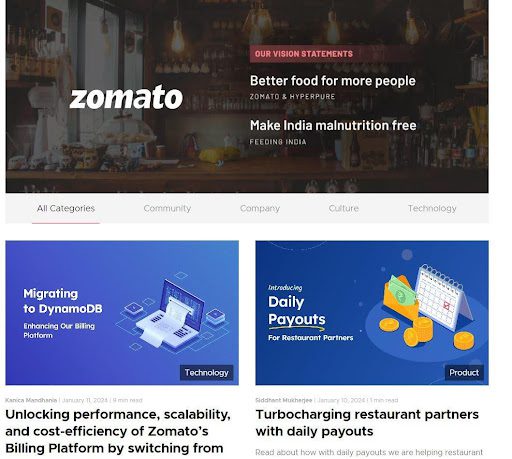
It helps them engage a steady number of traffic, promote communication and foster relationships with partners and restaurants. As per Semrush, the blog section of Zomato has enhanced its traffic in the last 1 year along with its authority in the industry.

2. SEO Content Writing
SEO optimized content writing has proven to be an effective tool for the growth of a business. By offering reliable and quality information about some of the most searched topics on Google, companies can help with SEO content to increase their online visibility.
This helps you get more people to learn about your products and services.
Example – Stable Money
One of our clients Stable Money has consistently availed our SEO optimized content over the last year to emerge as a trusted brand online.
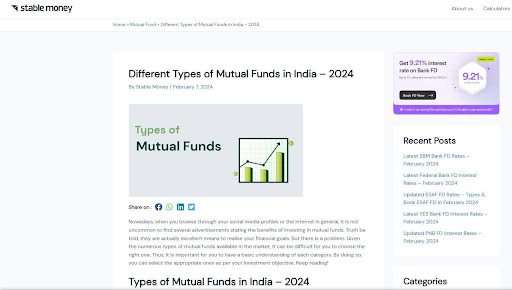
From merely a few thousand monthly users, the website of Stable Money has recorded more than 40K monthly traffic following the examples of content writing. With enhanced visibility, Stable Money strengthened its brand value to claim trustworthiness among the audience.
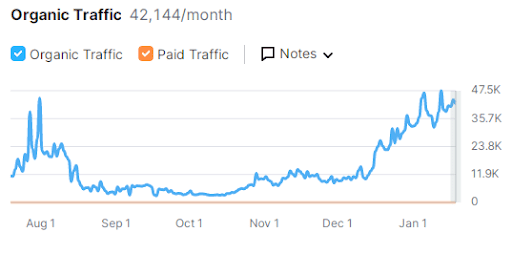
3. Website Content Writing
High quality, contextual and relevant content writing for the website has its own advantages. Especially when you are operating through an online model, your website becomes the mouthpiece of your brand.
Value-driven, authoritative descriptions highlighting the benefits of the products and services send out a clear message about your reliability.
Example – HubspotAs specialists in offering digital marketing solutions, Hubspot has cracked the code long ego and uses authoritative and reliable content writing on its website. The screenshot below illustrates an example of b2b content writing.
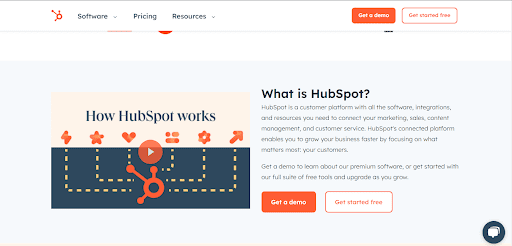
Hubspot clearly defines its use case and utility in a single paragraph that informs its audience with a clear call to action.
4. Footer Content Writing
SEO optimized footer content plays a major role for eCommerce platforms to secure better visibility on search engines. Footer content helps you customize the page with relevant transactional keywords that not only increase organic traffic to your product pages but also inform the buyers about the product and services.
Example – Myntra
The subsidiary brand of Flipkart, Myntra is a renowned fashion and lifestyle eCommerce platform. In spite of having a steady demand among the youth, Myntra does not leave a stone unturned to strengthen its brand visibility.
The eCommerce platform ranks in the top 3 positions for several transactional keywords. This is achieved by having SEO optimized footer content on the product pages. Below is an example of content writing for the footer section. It is placed after the list of products, towards the end of the page.
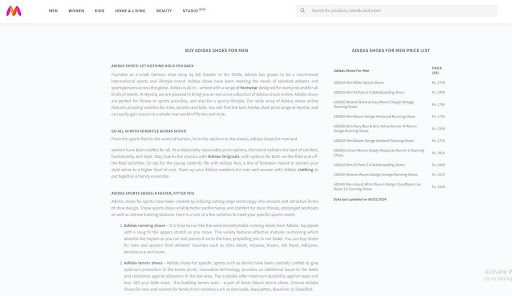
5. Whitepaper
For any company, a Whitepaper serves a useful purpose to inform and guide its audience through its problems and agendas. Especially for B2B companies, white papers are a crucial content writing example that engages and educates investors and clients.
Example – Cisco
As one of the market leaders in B2B sector, Cisco is a renowned name in offering cyber security solutions. They maintain authority and relevance in the industry by offering authoritative information to the audience and stakeholders.
The following is a screenshot from the Cisco Edge whitepaper which delves deeper into internet security.
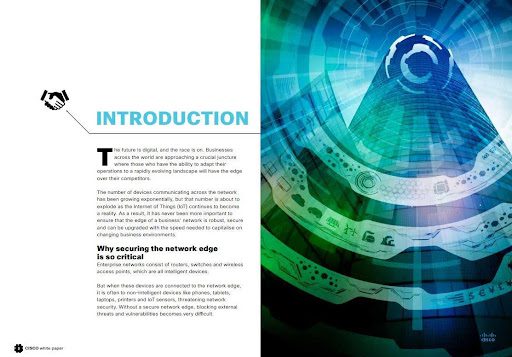
6. eCommerce Product Descriptions
Engaging and brand optimized product descriptions help eCommerce stores to stand out and differentiate from other competitors. Apart from improving the user experience on the website, quality product descriptions reflect a brand’s personality and objectives. Overall, eCommerce product descriptions help you personalise the user experience by better informing the audience.
Example – Bose
As a renowned global leader in producing premium audio solutions, Bose develops on its brand identity with authoritative product descriptions. With a signature emphasis on its technology, Bose differentiates itself from its competitors. This makes Bose’s product descriptions a fine example of quality content writing.

7. Company Profile Writing
The value of a high quality company profile is irreplaceable in digital marketing. Whether you are a new player in the market or trying to optimize your established brand for the younger generation, a unique company profile becomes the mouthpiece of your brand.
Traditionally featured on the About Us section of a website, a company profile introduces the audience to the story of the brand.
With a catchy and attractive profile, you encourage the audience to identify with your missions and objectives. In addition, they help you communicate directly and honestly with customers and stakeholders to create an everlasting bond that helps your business grow.
Example – Starbucks
Aside from turning coffee into a gourmet experience, Starbucks made its name through a story. Below is the company profile of Starbucks, an example of high quality personalised content writing.
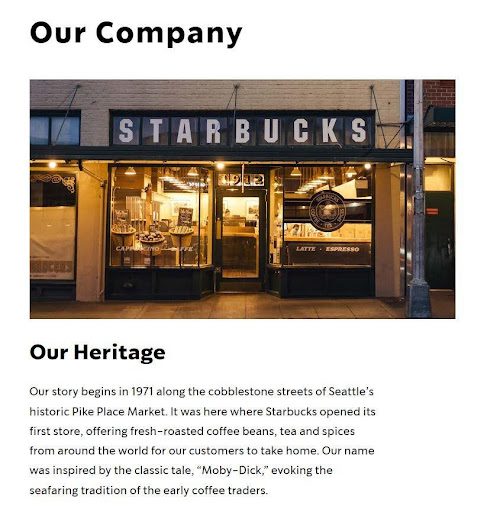
8. Pillar Content/Authoritative Content
Authoritative content is one of the crowning jewels of any content marketing campaign. Especially if you are a B2B enterprise, showing trustworthiness is vital to drive new clients. With authoritative and pillar content, you educate clients and stakeholders about your industry.
By consistent distribution of long-form content, you can establish your position as a thought leader and an authority in the industry.
Example – Neil Patel
Neil Patel is a popular name in the world of online marketing. He is known as one of the most trusted authority in SEO. Neil offers valuable advice and knowledge on various digital marketing topics through authoritative content.
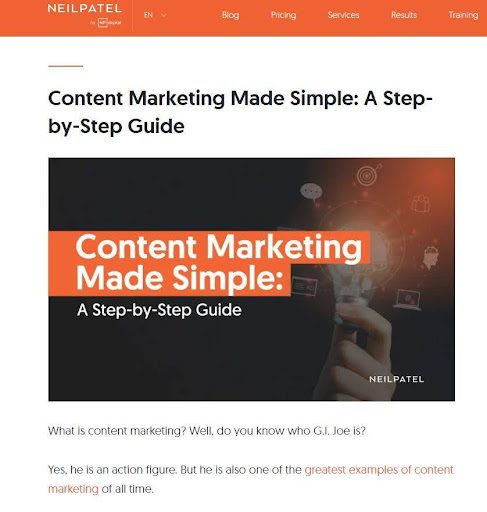
His impeccable writing skills and experience with marketing make all of Neil’s blogs highly engaging while serving value to the readers.
9. Case Studies
Whether you are planning to secure the next round of investments or to bag a top client in the industry, case studies are a powerful tool in your arsenal. It lets you showcase your analytical skills and produce data-driven approaches.
In a nutshell, good case study portfolios with customised narratives are the driving force in your journey to scale.
Example – Deloitte
As one of the Big 4 financial solutions firms, Deloitte maintains its authority in the industry with in-depth case studies. The case studies mostly cover the solutions offered by Deloitte to the clients and how they went on to help the business. The following is an example of a Deloitte case study.

10. Email Newsletters
Newsletters are an efficient tool that allows you to guide your audience through the marketing funnel. With useful updates and information, professional newsletters contribute value to your email list and encourage them to visit your website.
Apart from serving the immediate role of guiding the audience further into the bottom of the funnel, email newsletters are a good source to draw organic traffic to your website as well. Depending on your business model, newsletters also keep your investors and stakeholders informed.
Example – Samsung
Besides being one of the top players in the Android ecosystem, the South Korean company Samsung also offers many tech-enabled solutions to companies worldwide. The company manages it all with a robust marketing strategy across different channels to promote continuous communication with the public.
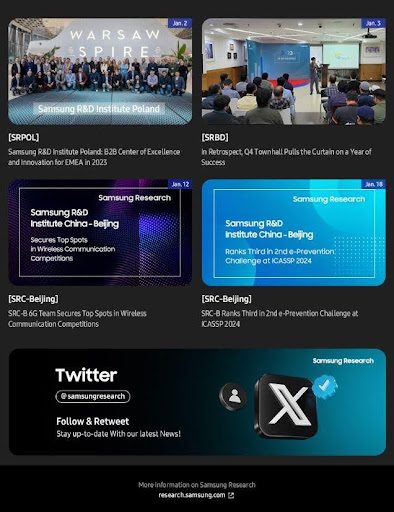
The newsletter by Samsung Research is one such tool that keeps people informed on the latest developments in the R&D department of the company.
11. Landing Page Copy
Landing page copywriting is one of those useful ways to harness the power of persuasive writing to convert audiences into customers or clients.
They are designed to draw an audience with transactional search intent and encourage them to convert by highlighting the USPs of your product and services. Once the user is redirected to the landing page, engaging copy piques their interest and nudges them to take action.
Example – Shopify
The B2B eCommerce platform allows small businesses to create online stores and accelerate their sales. The following example is of Shopify’s landing page. The copy on the page is clean, to-the-point and highlights the USPs of the platform – encouraging quick form fill-up.

12. How-To Content
From tutorials on wearing a tie to DIY guides, how-to content is an absolute ruler in the online content industry. How to perform a particular task ranks one of the top search queries on Google. Whether you are looking for how to rank higher or to boost your conversions, this genre of content is highly popular and engages and sizeable chunk of your target group.
With the right method and helpful tips, how-to content is an easy way to drive search traffic to your website and grow organically in your industry.
Example – WikiHow
Perhaps the most renowned site for how-to content writing examples is wikiHow. From personal care, and relationship advice to DIY guides about creating a bookmark, the website seems to have it all.
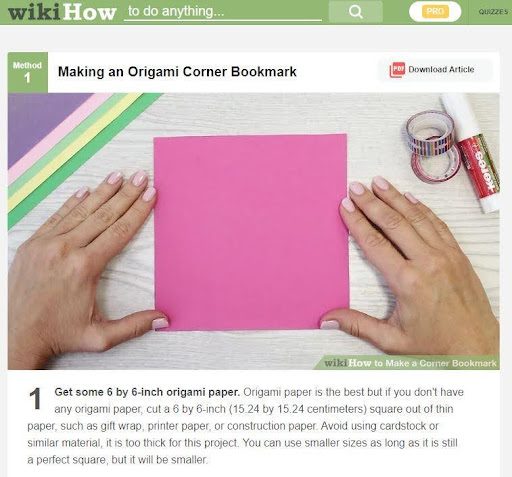
13. Social Media Posts
In order to enhance one’s position in the industry, social media content has become an indispensable tool. Social media platforms like Facebook, Instagram, Snapchat, and LinkedIn have a large number of daily active users. As per your target group, sharing witty, socially relevant posts is a suitable strategy to increase brand awareness. This helps more people to interact with your brand and increase market reputation.
Example – Amul
Whether it is about offering a quip on a social issue, celebrating any victory or paying homage to a legend – Amul’s social media posts are designed to engage the public with topically relevant cartoons. Typically, the cartoon would have the Amul mascot with a topical illustration and caption.
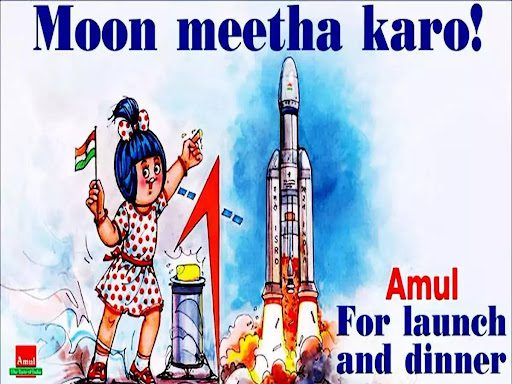
The above cartoon denotes the event of Chandrayaan 3, India’s Lunar Probe’s successful landing on the moon. Paired with a pun on the ‘moon’, Amul’s cartoons are a brilliant example of content writing as well as creative illustration.
14. Copywriting
Copywriting is a full spectrum label used for a short, attractive copy to communicate effectively with your audience. From writing witty captions for products to creating engaging app push notification copies – the examples of sales-driven content writing are several.
Example – Apple
Apple dominates the tech market when it comes to creating top-notch copywriting that creates a whole new experience for the audience.
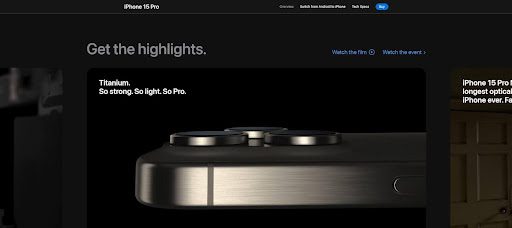
By using highly engaging and sensory language, Apple does not only sell a product but strives to sell an experience to the audience.
15. Video Content Writing
As many people are visual learners (cite stats), text-only content may exclude a sizeable portion of your audience. That is where data-driven, visually engaging content creation ideas prove useful to capture these potential leads. Whether it is short-form videos or full-length authoritative videos, backed by a quality script and properly planned video content has the ability to engage people for longer and create higher impacts.
Here is an example of creating engaging video content:
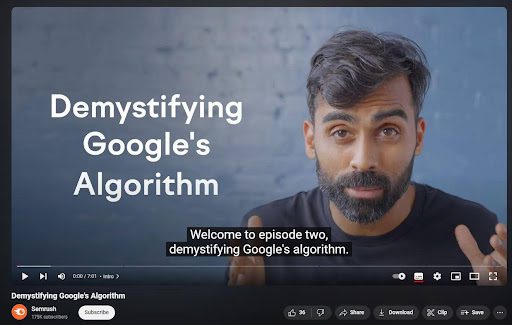
Backed by a robust script, Semrush’s videos contribute value to the audience with easy-to-understand analogies and explanations.
Simplifying complex ideas and jargon is one of the effective content writing examples that engage the readers.
Top 7 Content Writing Strategies to Get the Best Results
When leading your business with a content-based marketing campaign, it is essential to align it with the requirements of the industry. To get the most out of your content marketing, consider using the following strategies:
1. Maintain Information Architecture
Having the right flow of information is the primary requirement for creating high-quality content. A good rule of thumb is to use the inverted pyramid structure i.e. mention the most important information at the very first.
Then go on to point out the additional facts and figures that may corroborate your arguments. Also, with proper subhead distribution and shorter paragraphs, your content can help reduce the cognitive load of the audience.
2. SEO Optimize your Content
It is kind of a no-brainer but SEO optimization is an essential quality for any web content. With the right set of keywords, you enhance the chances of getting ranked at the top of the SERP.
Further, organic incorporation of keywords and strategic placements helps you define your search intent and target audience.
3. Address Audience’s Pain Points
One of the most useful ways to create engaging content is to start by addressing the problems of the user. By highlighting the issues suffered by the target group, you have the potential to immediately hook the readers’ attention.
Properly addressing and solving the issues of the readers helps you gain their confidence and in turn receive their loyalty to your brand.
4. Pay Attention to the Semantics
We cannot stress on this enough, using the right words as per your industry and target audience has a huge potential on the rank of a content.
Depending on if you are a B2B or a B2C enterprise, the language will differ a lot. For instance, B2B companies always try to provide authoritative information over flashy offers to attract clients. Whereas for consumer-focused businesses, offers and discounts are a major factor in driving sales.
5. Ensure Uniform Tonality
By following the content writing examples you may choose a diverse set of mediums and formats for content distribution.
Yet, if you want to get effective results, ensure to use a uniform tone across different channels and types of content. This ensures a cohesive brand identity that engages the audience and builds your credibility.
6. Use Visuals for Better Understanding
Since many people are visual learners, using visual cues in your text content such as graphs, charts and diagrams proves to be more engaging.
A mix of different visual elements like GIFs, short videos, and infographics prove to be more apt to promote better understanding and retention of the information. And of course, any audience that you may benefit from your information will remain a loyal customer for you.
7. Learn from Feedbacks
The essential idea behind content marketing is to promote communication. A good writing should enkindle communication among your peers and readers, and that is the ideal scenario you would want to achieve with your campaign.
So, actively encourage people to comment on your posts and create surveys to get their input. Once you have accumulated enough data, find out the factors and areas where the audience is giving feedback and implement them in your future posts.
Content Writing Tools to Ease Your Job
Upon looking at some of the best content writing examples, you should be all set to launch your content marketing campaign. To help you with your journey of creating quality content, get help from some of the popular tools on the web.
They help you optimize content for the web and maintain an easy flow that allows you to draw increased readers and enhance your position on the search engine ranking page.
1. Hemingway Editor
Hemingway Editor is a popular and free tool for writing content. The easy-to-use web-based interface helps you write straightforward SEO-optimized pieces of content that are easy to read and perform well on the internet.
With readability checks, Hemingway editor makes it easy for content writers to write efficiently. The platform has recently introduced an AI-powered beta model where AI fixes errors for the writers. This is a must-try!
2. Grammarly
Standing through the test of time, Grammarly continues to be one of the favourite tools for content writers out there. The grammar checker and proofreading tool make it super easy to fix typos, and grammatical errors and proofread each article within a few minutes. The AI-based tool also has smart suggestions to improve the quality of your writing.
By checking factors like accuracy, clarity, engagement and delivery – Grammarly helps you create flawless articles with consistent tonality.
3. Copyscape
For web content plagiarism is a major threat which may invite penalties to your site. To ensure plagiarism-free SEO optimized content, use Copyscape to check your content for potential plagiarism.
Since it is a paid tool you will have to allocate some resources for plagiarism proofing your content. But that is a small price to pay to avoid penalties and copyright lawsuits.
4. Yoast SEO
Yoast is an indispensable tool for every SEO content writer out there. It ensures your content maintains proper keyword density and follows all other optimization criteria to get rank on Google and other search engines.
So, we would insist you to check it out while you browse the content writing examples for your campaign.
5. Google Analytics
Keeping a track of the technicalities are essential to produce top quality content. Google Analytics offers valuable data to track your website’s performance. Keep a track on factors like session time, bounce rate, page views.
The tools also let you in on the approximate location of your website visitors. All this should help you plan your content to align it with your actual audience.
6. Google Trends
The only problem with Google Trends is that people do not talk about it enough! The powerful tool offers search trends against each keyword for you to take informed decisions.
Use this tool to plan your keyword strategy according to what is up and trending and see your website get flooded with new visitors.
5 Useful Tips for Content Marketing in 2024
AI and data are some of the most sought-after skills in the content marketing industry in 2024. Implement the following tips and strategies to ensure your campaign remains and fresh and relevant:
1. Make Websites AI-friendly
As people go on to search on AI tools and platforms like Bing’s ChatGPT-enabled Co-Pilot, traffic through search alone is going to take a hit. However, the good news is, these AI chatbots often take information from the web and offer its sources as well.
So, writing easy-to-understand content with a properly defined content architecture will not only help you rank better but appear in AI-generated answers as well. It will ensure you get traffic via AI-generated responses.
2. Use Schema to Define Your Pages Better
Schema markup is a short line of code that helps search engines better understand the content of your post and its relation to the topic. To ensure that your flawless content deserves the right attention, using the right schema for a page is vital.
So, if you are trying to get rank for local searches, using a local schema for your location pages will produce rapid results.
3. Repurpose your content
Not all content needs to be brand new. Frankly, coming up with brand-new topics for different marketing channels every day can be quite tiresome and resource-intensive. That is why, repurposing evergreen content is the go-to marketing strategy for 2024.
Use your blog posts and authoritative content to create short infographics or create a podcast out of them. When posting on external websites, using an advanced paraphrasing tool can help you save some time while streamlining your content repurposing. You can always use new mediums such as LinkedIn or Instagram for carousel photo posts to engage an audience and ignite conversations.
4. Define Your KPIs
Defining and identifying your KPIs (Key Performance Indexes) are a good start to getting quantifiable results out of content marketing. Whether you are trying to boost traffic, increase visibility, or get more organic conversions, identifying the goals and optimizing your content strategy accordingly always proves useful.
5. Create a Content Calendar
One of the best content creation tricks is to back your marketing campaign with a robust plan. A content calendar serves that exact purpose whereby one can schedule future posts, and keep track of the previous publications and their performances.
It ensures proper content tracking across multiple channels which in turn helps you formulate data-driven solutions to the challenges you encounter.
8 Steps to Create Awesome Marketing Content for Your Business
In the fast-paced world of digital marketing, creating examples of compelling content writing is essential for capturing the attention of your target audience. Whether you’re a seasoned marketer or just starting, a strategic approach to content creation can significantly impact your business.
Here are eight steps to guide you in creating awesome marketing content that resonates with your audience and drives results.
1. Research Your Target Audience
Understanding your audience is the cornerstone of effective content creation. Conduct thorough research to identify your target audience’s demographics, interests, and pain points. Utilize tools like Google Analytics, social media insights, and customer surveys to gather valuable data. By knowing your audience, you can tailor your content to meet their needs and preferences.
2. Competitor Analysis
Stay ahead of the competition by analyzing what others in your industry are doing. Identify your competitors and analyze their content strategies. Look for gaps in their approach that you can capitalize on, and learn from their successes and mistakes. This analysis will help you refine your content strategy and differentiate your brand.
3. Keyword Research
Keyword research is crucial for optimizing your content for search engines. Use tools like Google Keyword Planner or SEMrush to identify relevant keywords in your industry. Incorporate these keywords naturally into your content to improve its visibility on search engine result pages (SERPs). This will enhance your chances of reaching a wider audience.
4. Determine the Type of Content
Different types of content writing resonate with different audiences. Depending on your goals and target audience, choose the most suitable content types, such as blog posts, infographics, videos, or podcasts. Consider the preferences of your audience and the nature of your message when deciding on the format of your content.
5. Create an Outline
Before diving into the writing process, create a detailed outline for your content. This helps you organize your thoughts, maintain a logical flow, and ensure that you cover all relevant points. The outline serves as a roadmap for your content creation, making the writing process smoother and more efficient.
6. Write & Edit
With a solid outline in place, start writing your content. Craft engaging headlines and introductions to capture your audience’s attention. Maintain a clear and concise writing style, and ensure that your content provides value to the reader. Once you’ve written the initial draft, go through a thorough editing process to eliminate errors and enhance clarity.
7. Optimize
Optimizing your content for search engines is vital for improving its discoverability. Include relevant keywords in strategic locations such as the title, headings, and throughout the body of the content. Additionally, optimize meta tags, image alt text, and other on-page elements. This will contribute to better search engine rankings and increased organic traffic.
8. Track Performance
After publishing your content, monitor its performance using analytics tools. Track key metrics such as website traffic, engagement, and conversion rates. Analyze the data to understand what is working well and what needs improvement. Use this feedback to refine your future content strategies and continuously enhance your marketing efforts.
Takeaway
Since content distribution involves different styles of writing across multiple channels, it is vital to maintain a uniform tonality. Tonal or thematic resemblances are essential to create brand optimized high quality content.
Finally, when opting for content marketing, utilizing a mix channel of several content writing examples always proves beneficial to accelerate the growth of your business.

Achinta Maity, a former professional SEO content writer for Das Writing Services, is currently working as an SEO Analyst. During his long tenure as a writer, he has worked for multiple clients from various industries, including finance and digital marketing. Due to his passion for writing and sharing knowledge, he contributes to our blog besides working as an SEO Analyst. For any queries, you can contact him on his LinkedIn profile.







Leave a comment
All comments
binance
Thank you for your sharing. I am worried that I lack creative ideas. It is your article that makes me full of hope. Thank you. But, I have a question, can you help me?
Sumedha Gupta Choudhury
The tips are valuable and will help me curate informative content.
Arghish Das
Great article! It's really helpful for anyone looking to learn about digital marketing. I especially liked the part about reaching a global audience.